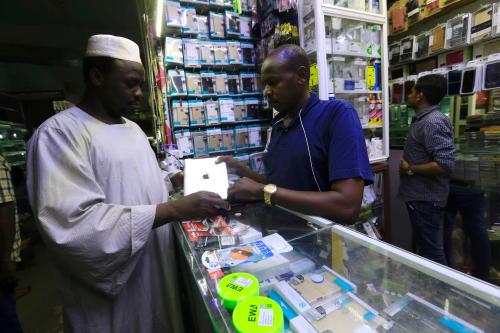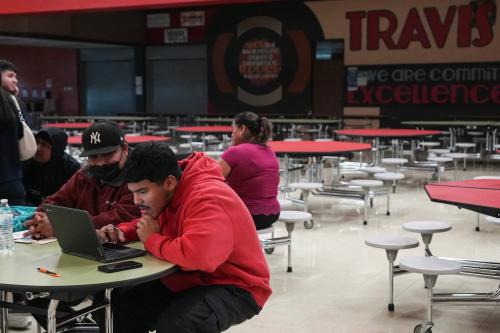Below is a viewpoint from Chapter 5 of the Foresight Africa 2018 report, which explores six overarching themes that provide opportunities for Africa to overcome its obstacles and spur inclusive growth. Read the full chapter on African technology, innovation, and digital potential here.
The talent and energy of Africa’s young people is being poorly served by many of its underperforming education systems. Across low-income countries, only 8 percent of children are on track to master basic secondary education level skills in such areas as math, language, and critical thinking.[1] According to our analysis, it will take the average student in sub-Saharan Africa almost 100 years to catch up to the average student in high-income countries in terms of how many years of school she will attend and how much she will learn.[2] Given that the numbers of young people in Africa are only set to increase in the coming years, education systems must find new ways of fully supporting their talents.
Investing in Africa’s young people by giving them the skills they need for the future is perhaps one of the smartest strategies for accelerating progress in the region. Some argue that this education-led growth is the way of the future, particularly when analyzing the changes technology will likely reap on jobs, including transforming many low-skilled jobs into ones that will require more complex, non-routine cognitive and inter-personal tasks.
Therefore, the question remains: Can the creativity and innovation that is taking place across Africa be harnessed to help rapidly accelerate education progress? This is a question we examined in the recent report Can We Leapfrog? The Potential of Education Innovations to Rapidly Accelerate Progress. Around the world, Africa is well known as a leader in “leapfrog development,” namely accelerating development progress by skipping entire phases of infrastructure- and institution-building. Mobile banking is a successful example. If such rapid, nonlinear progress is possible in these areas, why could the same not be true in education?
It will take the average student in sub-Saharan Africa almost 100 years to catch up to the average student in high-income countries in terms of how many years of school she will attend and how much she will learn.
It is possible but will require significant shifts in the way education is done.[3] Already, sub-Saharan Africa is ripe with education innovations, making up 23 percent of the catalog. In our study, countries such as Kenya, South Africa, and Uganda are hotspots of education innovations, hosting approximately 60 percent of the innovations from the region.
Most technology-based education innovations in the region utilize existing tools in new ways.
Given the scope and scale of the education challenges we face, well-deployed technology can provide meaningful support to global leapfrogging efforts. In sub-Saharan Africa, innovators are leveraging technology to reach out-of-school children, enhance classroom engagement, disseminate classroom materials, and track student progress, among other things. For example, television and SMS technology are often used to deliver content to children and teachers, and information and communication technology centers, providing materials and training opportunities, are increasing educational access both in and outside of schools. Most technology-based education innovations in the region utilize existing tools in new ways. Eneza Education, with its reliance on SMS, is one example of such practices. A private sector program operating in Ghana, Kenya, Tanzania, and Zimbabwe, Eneza provides students with mobile access to quizzes connected to the national curriculum. After completing the assessments via text, students receive feedback and mini-lessons targeting areas where they need support. Teachers use their phones to track student progress, identifying students’ strengths and weaknesses. The results of such interventions are promising: Internal evaluation results showed that students who used Eneza increased their scores by 5 percent compared to a control group.
With an openness to innovation, sub-Saharan Africa shows great promise for leapfrogging in education. Though projects that utilize technology to transform existing education practices are currently outliers in educational innovations, they offer bright examples of the potential to close the 100-year gap. If we are to leapfrog education for learners in Africa and beyond, we must make room for bold new approaches; transformative technology has the potential to support such rapid progress.
Katie Langford contributed to this piece.
footnotes
1. The International Commission on Financing Global Education Opportunity. The Learning Generation: Investing in education for a changing world. September 2016.
2. Winthrop, R., & McGivney, E.. Why wait 100 years? Bridging the gap in global education. The Brookings Institution. June 2015.
3. In our report, Can We Leapfrog? The Potential of Education Innovations to Rapidly Accelerate Progress, we lay out a leapfrog pathway for education that centers on four essential domains: learning and teaching, recognizing and learning, people and places, and technology and data. Against this pathway, we have developed and analyzed a catalog of nearly 3,000 education innovations around the globe and identified promising approaches that could help young people leap ahead in their education.







Commentary
Foresight Africa viewpoint – Can technology help leapfrog education in Africa?
January 23, 2018
Rebecca Winthrop and Katie Langford discuss how education innovations are helping close the education gap in sub-Saharan Africa.